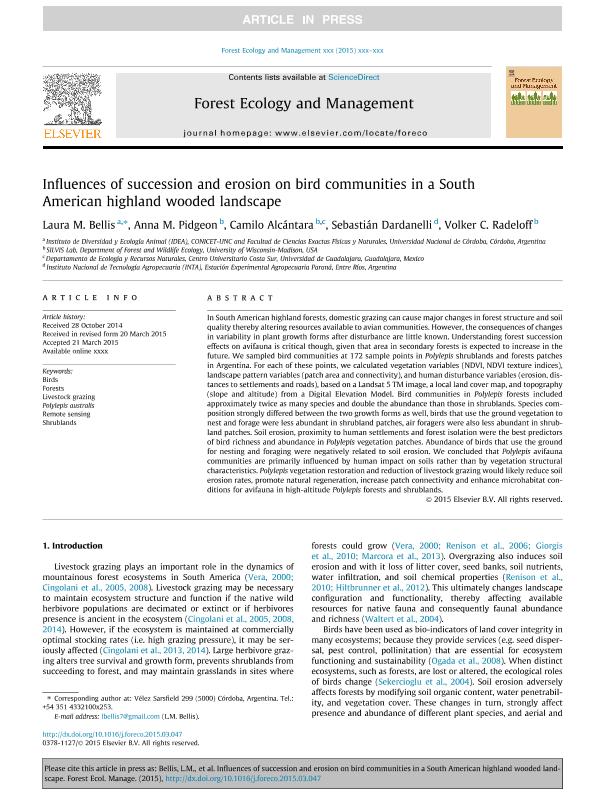Mostrar el registro sencillo del ítem
dc.contributor.author
Bellis, Laura Marisa

dc.contributor.author
Pidgeon, Anna Michle

dc.contributor.author
Alcántara, Camilo
dc.contributor.author
Dardanelli, Sebastián

dc.contributor.author
Radeloff, Volker

dc.date.available
2018-07-05T14:57:40Z
dc.date.issued
2015-08
dc.identifier.citation
Bellis, Laura Marisa; Pidgeon, Anna Michle; Alcántara, Camilo; Dardanelli, Sebastián; Radeloff, Volker; Influences of succession and erosion on bird communities in a South American highland wooded landscape; Elsevier Science; Forest Ecology and Management; 349; 8-2015; 85-93
dc.identifier.issn
0378-1127
dc.identifier.uri
http://hdl.handle.net/11336/51325
dc.description.abstract
In South American highland forests, domestic grazing can cause major changes in forest structure and soil quality thereby altering resources available to avian communities. However, the consequences of changes in variability in plant growth forms after disturbance are little known. Understanding forest succession effects on avifauna is critical though, given that area in secondary forests is expected to increase in the future. We sampled bird communities at 172 sample points in Polylepis shrublands and forests patches in Argentina. For each of these points, we calculated vegetation variables (NDVI, NDVI texture indices), landscape pattern variables (patch area and connectivity), and human disturbance variables (erosion, distances to settlements and roads), based on a Landsat 5 TM image, a local land cover map, and topography (slope and altitude) from a Digital Elevation Model. Bird communities in Polylepis forests included approximately twice as many species and double the abundance than those in shrublands. Species composition strongly differed between the two growth forms as well, birds that use the ground vegetation to nest and forage were less abundant in shrubland patches, air foragers were also less abundant in shrubland patches. Soil erosion, proximity to human settlements and forest isolation were the best predictors of bird richness and abundance in Polylepis vegetation patches. Abundance of birds that use the ground for nesting and foraging were negatively related to soil erosion. We concluded that Polylepis avifauna communities are primarily influenced by human impact on soils rather than by vegetation structural characteristics. Polylepis vegetation restoration and reduction of livestock grazing would likely reduce soil erosion rates, promote natural regeneration, increase patch connectivity and enhance microhabitat conditions for avifauna in high-altitude Polylepis forests and shrublands.
dc.format
application/pdf
dc.language.iso
eng
dc.publisher
Elsevier Science

dc.rights
info:eu-repo/semantics/openAccess
dc.rights.uri
https://creativecommons.org/licenses/by-nc-sa/2.5/ar/
dc.subject
Birds
dc.subject
Forests
dc.subject
Livestock Grazing
dc.subject
Polylepis Australis
dc.subject
Remote Sensing
dc.subject
Shrublands
dc.subject.classification
Otras Ciencias Biológicas

dc.subject.classification
Ciencias Biológicas

dc.subject.classification
CIENCIAS NATURALES Y EXACTAS

dc.title
Influences of succession and erosion on bird communities in a South American highland wooded landscape
dc.type
info:eu-repo/semantics/article
dc.type
info:ar-repo/semantics/artículo
dc.type
info:eu-repo/semantics/publishedVersion
dc.date.updated
2018-07-04T19:25:54Z
dc.journal.volume
349
dc.journal.pagination
85-93
dc.journal.pais
Países Bajos

dc.journal.ciudad
Amsterdam
dc.description.fil
Fil: Bellis, Laura Marisa. Consejo Nacional de Investigaciones Científicas y Técnicas. Centro Científico Tecnológico Conicet - Córdoba. Instituto de Diversidad y Ecología Animal. Universidad Nacional de Córdoba. Facultad de Ciencias Exactas Físicas y Naturales. Instituto de Diversidad y Ecología Animal; Argentina
dc.description.fil
Fil: Pidgeon, Anna Michle. University of Wisconsin; Estados Unidos
dc.description.fil
Fil: Alcántara, Camilo. University of Wisconsin; Estados Unidos. Universidad de Guadalajara; México
dc.description.fil
Fil: Dardanelli, Sebastián. Consejo Nacional de Investigaciones Científicas y Técnicas; Argentina. Instituto Nacional de Tecnología Agropecuaria. Centro Regional Entre Ríos. Estación Experimental Agropecuaria Paraná; Argentina
dc.description.fil
Fil: Radeloff, Volker. University of Wisconsin; Estados Unidos
dc.journal.title
Forest Ecology and Management

dc.relation.alternativeid
info:eu-repo/semantics/altIdentifier/doi/https://dx.doi.org/10.1016/j.foreco.2015.03.047
dc.relation.alternativeid
info:eu-repo/semantics/altIdentifier/url/https://www.sciencedirect.com/science/article/pii/S0378112715001875
Archivos asociados
